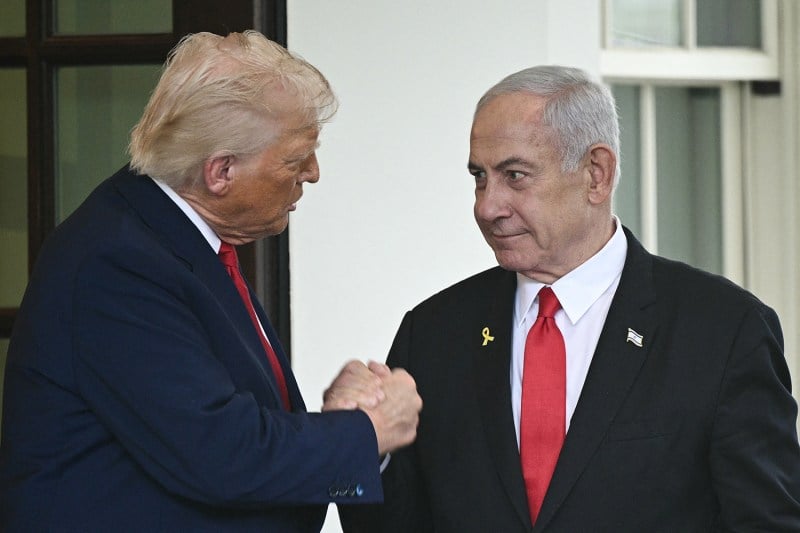Why Trump Could Succeed in the Mideast Where Other Presidents Failed

Why Trump Could Succeed in the Mideast Where Other Presidents Failed
The dealmaker president has been willing to pressure Israel and not just the Palestinians.
U.S. President Donald Trump shakes hands with Israeli Prime Minister Benjamin Netanyahu as Netanyahu departs the White House in Washington on April 7. Brendan Smialowski / AFP via Getty Images
The rupture of the Israel-Hamas cease-fire agreement in March could spell the end of any prospect for a comprehensive agreement between Israelis and Palestinians—or it could mobilize efforts for such a deal. Everything hinges on U.S. President Donald Trump and what he chooses to do next.
A plan endorsed by Arab leaders in Cairo last month provides an approach for rebuilding Gaza without the displacement of its population and charts a path for a Palestinian-Israeli peace. Unaddressed, however, is how to get Hamas to agree to give up its arms.
The rupture of the Israel-Hamas cease-fire agreement in March could spell the end of any prospect for a comprehensive agreement between Israelis and Palestinians—or it could mobilize efforts for such a deal. Everything hinges on U.S. President Donald Trump and what he chooses to do next.
A plan endorsed by Arab leaders in Cairo last month provides an approach for rebuilding Gaza without the displacement of its population and charts a path for a Palestinian-Israeli peace. Unaddressed, however, is how to get Hamas to agree to give up its arms.
Stabilizing the security situation in Gaza requires addressing such questions in an agreement between the two largest Palestinian political factions—Fatah, the ruling party of the Palestine Liberation Organization (PLO) and the Palestinian Authority, and Hamas. Because Israel aims to prevent the emergence of an independent Palestinian state, such an agreement will only be implementable if the United States supports it and uses its leverage to ensure that Israel doesn’t undermine it.
The Trump administration’s out-of-the-box thinking, direct engagement with Hamas, and willingness to apply pressure on friend and foe alike have uniquely situated Trump as the U.S. president to achieve this.
The Trump administration has said that it doesn’t want war. It prefers to make deals in the Middle East—big deals. And the biggest one of all, a Saudi-Israeli normalization agreement, is on Trump’s mind. The Kingdom of Saudi Arabia, however, has made clear that normalization is off the table so long as Israel continues to prevent a Palestinian state.
The White House’s special envoy to the Middle East—Steve Witkoff, who has been tasked with getting both of the two interlinked deals done—has expressed what should be common sense about his job of mediating between two opposing sides: A good deal has to work for everybody. And so the New York real estate developer and close friend to Trump began his efforts by ascertaining what Hamas and Israel want.
But asking what both sides want is not the usual U.S. approach. During the successive attempts at Israel-Palestine peacemaking, U.S. mediators made painstaking efforts to understand Israel’s bottom line—and then went about working on a plan for how to make Palestinians agree to it.
Not only did Witkoff want to know what Palestinians were thinking, but he also went to Gaza to see the situation for himself, something that no high-ranking U.S. executive branch official has done in more than two decades. Another Trump advisor, Adam Boehler, did something even more out of the box (and contrary to U.S. policy)—he met directly with Hamas, which the State Department designates as a terrorist group.
Yet these efforts initiated by Trump’s envoys stand in contrast to the president’s statements indicating that he wishes to resettle Palestinians outside of Gaza. A survey published by the Nation in February found that 92 percent of Palestinians in the enclave, the vast majority of whom are refugees or descendants of refugees hailing from places such as Haifa, Jaffa, and Askelon, vehemently oppose their displacement. This is why during the six-week cease-fire, hundreds of thousands of displaced Palestinians chose to fold their tents, return by foot, and pitch them on the remains of their homes in northern Gaza rather than risk displacement to Egypt.
If Trump intended only to goad the Palestinian Authority and Arab states into coming up with a plan of their own, it worked. The Arab plan offers an approach for rebuilding Gaza without the displacement of its population and provides a road map for Palestinian sovereignty.
What is in the plan for Israel and the United States? Saudi-Israeli normalization, deepening and expanding relations with Arab and Muslim countries, and Israel’s regional integration that would finally open up business and investment opportunities. Raked by war, sanctions and instability, the Arab Middle East is ready for a better, more prosperous economic outlook for its young population. But Israel, the so-called start-up nation, needs one too if it doesn’t want the growing war crimes allegations against it and global calls for divestment, boycotts, and sanctions to turn it into the shut-down nation.
The Arab plan is the best hope for a permanent cease-fire and getting to a better future for Palestinians and Israelis. Among its problems, however, is that it sidesteps how Hamas might agree to give up governance in Gaza to the Palestinian Authority and turn over its weapons.
Stabilizing the security situation in Gaza—and in the West Bank—requires addressing governance and security arrangements head on. That begins with an agreement between Fatah and Hamas that allows the Palestinian Authority to take over governance until elections are practicable. Given Israeli opposition to Palestinian statehood, such an agreement will only be implementable if the United States supports it and uses its leverage to ensure that Israel doesn’t undermine it. This is something that Trump is uniquely situated to do.
Despite widespread reports and intelligence in the weeks and months after Oct. 7, 2023, that Israeli attacks on Gaza were indiscriminate and disproportionate, the Biden administration continued to supply Israel with offensive weapons. Even when Israeli Prime Minister Benjamin Netanyahu refused to accept the cease-fire deal negotiated in May 2024, the administration held back from deploying leverage to force his hand. It took Trump’s election to convince Netanyahu to implement virtually the same cease-fire deal in January 2025.
How did Trump do it? Netanyahu understood that the businessman meant business.
Trump knew what Netanyahu wanted most was to stay in power and that Netanyahu could politically absorb at least a temporary cease-fire without losing a key coalition partner who could bring down the government. It also helped that the Israeli public holds Trump in high regard and trusts his commitment to Israeli security and the release of Israeli captives held in Gaza. Saying no to Trump wasn’t just bad for Netanyahu, given his determination to prevent Iran from getting nuclear weapons; it was bad for him domestically given how deeply unpopular Netanyahu has become.
But the leverage that Trump used with Israel did not extend beyond the first phase of the cease-fire agreement. Trump agreed to give Israel a free hand to decide whether to enter negotiations with Hamas on the second phase of the cease-fire deal, which would have required Israel to completely withdraw its troops from Gaza. Without U.S. leverage, phase one of the cease-fire agreement ended. Israel closed the crossings into Gaza, halted entry of food and supplies, and resumed a massive bombing campaign.
Turning a six-week cease-fire into a sustainable truce will require the Trump administration to cast aside Netanyahu’s immediate personal motivations and domestic political calculations and prioritize the lives of Israelis and Palestinians and their long-term future.
Israelis want a cease-fire and all captives released. They are weary from repeated deployments on multiple Middle East battlefronts. They want to rebuild their economy and take advantage of opportunities that can only come from a stable, peaceful Middle East. And Israelis believe that Trump can deliver.
Palestinians, for their part, understand that Trump, unlike Biden, is willing to deploy U.S. power with adversaries and allies alike, including with Israel. What they are less certain about is whether the United States can support a deal that is both good for Israel and good for them.
What does a long-term truce that is good for everyone look like? Reconstruction of Gaza will not take place so long as Hamas remains the governing authority there. Donors, including Saudi Arabia, will not provide the estimated $53 billion in financial support necessary for projects if they will just be destroyed by Israel in the next escalation. Likewise, key stakeholders will not actively engage in the myriad ways needed to launch negotiations on a comprehensive peace so long as the political environment remains unstable.
Hamas has indicated a willingness to step back from governance in Gaza to allow the Palestinian Authority to take the reins. Israel should welcome this. The Palestinian Authority has been a reliable security partner in the West Bank for two decades. In recognition, the United States has maintained security assistance to the authority even as it has cut off foreign aid to much of the rest of the world.
Witkoff, the U.S. envoy, has stated that while Hamas can’t be allowed to rule, it can stay in Gaza and be involved—at least for a time. This grace period should start with Hamas and Fatah implementing the terms of the reconciliation agreement that was signed in Beijing last year.
International engagement is critical to break the impasse between Fatah and Hamas. Key stakeholders—Saudi Arabia, Egypt, Jordan, and the United Arab Emirates—should encourage the two main Palestinian political factions to agree on a formula to not only include Islamist parties in the PLO parliament, but also to better represent Palestinian civil society in the body—including in the form of unions, professional syndicates, diaspora communities, and youth and women’s committees. They should also offer an approach that is consistent with international best practices for incorporating members of armed groups in Gaza into Palestinian Authority security forces.
Hamas, Fatah, and all the political factions are already negotiating the makeup of the technical committee that would be responsible for the administration of Gaza. To deal with Hamas’s concern regarding the lack of capacity within the Palestinian Authority to maintain security, Arab stakeholders have indicated a willingness to commit troops for a UN-mandated mission in the occupied territories. However, the United States will need to use its influence with Israel to allow such forces to operate.
Trump has an opportunity. He will meet with the Saudi royal family in Riyadh in May on the first foreign trip of his second term. Unlocking Gaza’s reconstruction and laying the foundation for comprehensive regional peace will be on the agenda. The following month, Saudi Arabia will co-chair a summit of the Global Alliance for the Implementation of the Two State Solution in New York City, where the Arab plan—now endorsed by the United Kingdom, Germany, France, Italy, and the Organization of Islamic Cooperation—will be discussed.
The United States should not be sitting on the sidelines. It should work with allies and stakeholders to lay the foundation for a comprehensive peace and regional integration. That must start with encouraging Palestinian national reconciliation. No Palestinian-Israeli peace deal is possible, after all, if there isn’t a recognized Palestinian representative on the other side of the negotiating table holding a pen.
Such a deal hasn’t been possible with any other U.S. president—and that should be motivation enough for Trump to get it done.
This post is part of FP’s ongoing coverage of the Trump administration. Follow along here.
Zaha Hassan is a human rights lawyer and a fellow at the Carnegie Endowment for International Peace. Previously, she was the coordinator and senior legal advisor to the Palestinian negotiating team during Palestine’s bid for U.N. membership and was a member of the Palestinian delegation to Quartet-sponsored exploratory talks between 2011 and 2012.
More from Foreign Policy
-

An illustration shows a line of large shopping carts facing down a small Donald Trump figure holding two shopping bags. The stars of China’s flag are in the upper left corner. Why Beijing Thinks It Can Beat Trump
China’s elites have a new confidence in their own system.
-

U.S. Army Chief of Staff Randy George speaks to U.S. soldiers at the Hohenfels Training Area in southern Germany on Feb. 6. A Drawdown of U.S. Forces in Europe Is All but Certain
Here’s how the Pentagon can rebalance its approach to the continent without sacrificing U.S. interests.
-

University of California, Los Angeles students, researchers, and demonstrators rally during a “Kill the Cuts” protest against the Trump administration’s funding cuts on research, health, and higher education in Los Angeles on April 8. Why Authoritarians Attack Universities First
A Yale professor and expert on fascism talks about why he’s leaving the United States under Trump.
-

Dwight D. Eisenhower looks over a piece of paper while sitting on a couch as Robert Cutler looks over his shoulder. How Generations of Experts Built U.S. Power
And now Trump is throwing it all away.








Join the Conversation
Commenting on this and other recent articles is just one benefit of a Foreign Policy subscription.
Already a subscriber?
.
Subscribe
Subscribe
View Comments
Join the Conversation
Join the conversation on this and other recent Foreign Policy articles when you subscribe now.
Subscribe
Subscribe
Not your account?
View Comments
Join the Conversation
Please follow our comment guidelines, stay on topic, and be civil, courteous, and respectful of others’ beliefs.
Change your username |
Log out
Change your username:
CANCEL
Confirm your username to get started.
The default username below has been generated using the first name and last initial on your FP subscriber account. Usernames may be updated at any time and must not contain inappropriate or offensive language.